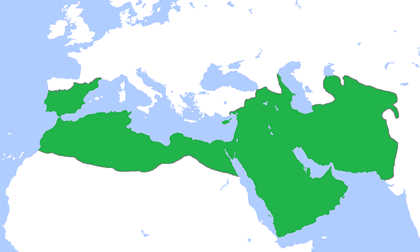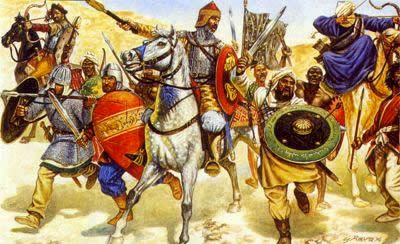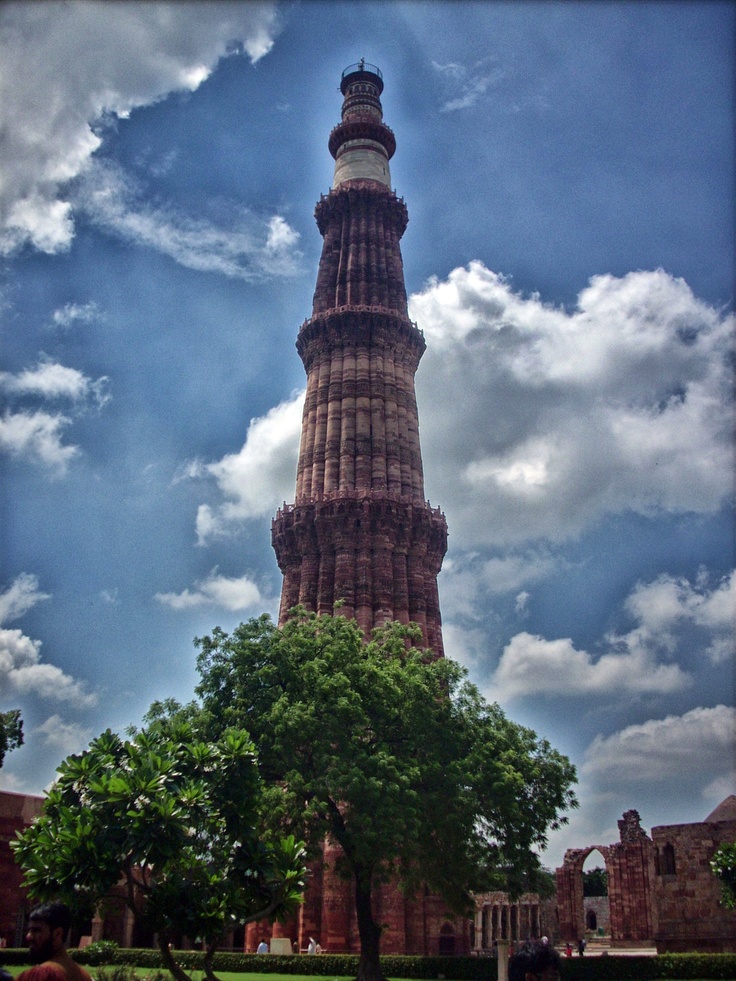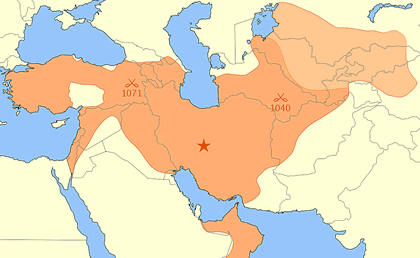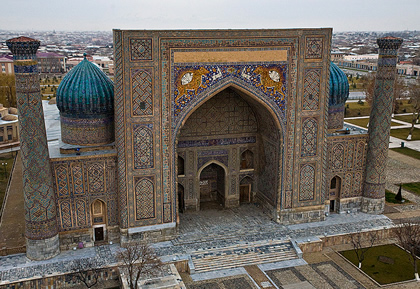 |
| Ottoman Empire |
The Ottoman Empire was a centralized absolute regime ruled from the top by the sultan. As in other nomadic and Islamic empires, the Ottomans never developed a legal procedure for accession and this was to be a source of instability and weakness.
The first sultans were among the most able sons of the sultans, and rival brothers were sometimes executed. By the 1600s, the oldest male members of the family were selected as sultans. Thus the sultanate passed among brothers or nephews and other possible heirs were kept under “house arrest” in various palaces.
The Ottoman Empire was a Sunni Islamic state, and although the sultans ultimately took the title of caliph, the Sheikh al Islam was the major religious authority of the state. In keeping with Islamic practice, there was no separation of religious and secular law in the early Ottoman Empire and the Shari’a was recognized as the law of the empire.
The Sheikh al Islam issued fatwas, legal opinions based on Islamic law, on matters ranging from the theological to the practical. Qadis, or Muslim judges, served in the provinces and local towns and muftis were appointed to give legal pronouncements if asked by the qadi.
Religious education was conducted in madrassas throughout the empire and the office of the waqf (pl. awqaf) oversaw religious endowments, many of which had been given by devout Muslims as zakat, or alms. Waqf endowments included hospitals, schools, retirement homes, public fountains, and soup kitchens.
Power Hierarchy
Politically, the vizier was the second-most powerful figure after the sultan. During the 18th century, when the sultans were weak or inept, the viziers, particularly the able and honest Koprülü family, managed the vast bureaucracy and government.
Early sultans governed through the imperial divan, or council, but ultimately the vizier oversaw the divan. A huge number of bureaucrats including scribes, translators, and clerks administered the day-to-day operation of the far-flung empire.
The sultans appointed valis, or governors, to rule over each province. To prevent governors from becoming too powerful, their terms in office were usually short; two years was the average. The constant administrative changes often led to inefficiency and corruption.
As a rule of thumb, the Ottomans exercised more direct authority in the provinces closest to the center of power in Istanbul; remote provinces, far from the center of power, enjoyed considerable autonomy and local families or officials often were the real sources of power.
Because remote regions such as Kuwait and Yemen often only gave an annual tribute to the Ottomans, it was sometimes unclear whether they were actually part of the empire. Unless protracted revolts broke out or people refused to pay taxes, the Ottomans generally interfered little in the daily lives of their subjects.
Militarily, the Janissaries composed the elite forces. They were conscripted through the devshirme system whereby young Christian boys from the Balkans were taken as slaves, converted to Islam, and trained as professional soldiers or administrators whose sole loyalty was to the state.
As the sultans became weaker, the Janissary corps became politically powerful and on occasion overthrew sultans to replace them with individuals of their own choice. The cavalry or sipahis, free-born Muslims, were given land as payment. Ownership of such land grants was sometimes hereditary. There were also a large number of conscripted foot soldiers.
Taxation
The collection of taxes was a perennial duduk perkara and the Ottomans developed a system of tax farming, or iltizam, in which multazim, tax collectors, were hired to collect taxes throughout the empire.
This system led to considerable abuses, and often unfair tax burdens were placed on the poorest peasants, who lacked the resources or power to avoid payment or to buy off the tax collector. Peasant farmers were often informally tied to the land, much of which was owned by old feudal families who retained their wealth under the Ottomans.
Religious minorities, Christians, Jews, and Armenians, lived under the millet system. They paid an additional tax but maintained their own schools, controlled their local communities, and settled legal disputes among their members.
The Ottoman Empire was remarkably tolerant of minorities, who enjoyed considerable upward mobility and economic freedom. Members of ethnic and religious minorities could and did rise to high positions, including that of vizier or physician to the sultan. Only the position of sultan was reserved for members of the House of Osman.
Agreements of capitulation were signed with foreign powers such as the French. Under the capitulations foreign merchants and others were granted rights to conduct business within the empire and were exempt from Ottoman taxation and laws. When the empire was strong, the capitulations were not a problem, but as the empire declined, the millet system and capitulations became sources of foreign economic and political interference.
Life as A Sultan
The sultan and his household ruled from the Topkapi in Istanbul. Topkapi was a sprawling complex of vast audience halls, throne rooms, living quarters for the harem, pleasure gardens and fountains, and a kitchen large enough to provide daily meals for 2,000 people.
The harem included the sultan’s wives, concubines, eunuchs, and the queen mother or Valide Sultan. Early sultans, like their counterparts in Europe and Asia, often married the daughters or sisters of defeated foes or wed to cement political and military alliances.
By the 16th century, sultans generally did not marry and Suleiman I the Magnificent’s marriage to his beloved Hurrem (Roxelana) was highly unusual. Women of the harem, particularly the Valide Sultan, exerted considerable political power during the 18th century.
They often conspired for their favorite sons to become the sultan. Although early sultans received firsthand training leading military forces and administering Ottoman provinces, by the 17th century royal princes were educated totally within the palace.
Their lack of outside experience and isolation within the harem made them poorly equipped to rule. Seventeenth-century sultans were often spoiled and self-indulgent with little or no awareness of the problems or corruption within ruling circles.
Ottoman Turkish was the language of the ruling elite and government. But as the language of the Qur’an, Arabic enjoyed a special place and was spoken as the first language by the Arabs who composed the majority of the population.
The Ottomans eagerly assimilated the artistic forms and cultures of those they ruled and often synthesized a wide variety of artistic forms into new, vibrant ones. A lavish court life with patronage of the arts evolved. As with most nomadic societies the Ottomans had a rich tradition of textiles and Ottoman artisans were known for their luxurious textiles, carpets, enameled tile work, and armor.
Ottoman Expansion
Following the collapse of Timurlane’s empire, Sultans Mehmed I (r. 1413–21) and Murad II (r. 1421–51) began the process of the reconquest and consolidation of the Ottoman Empire.
Mehmed enjoyed the support of the old Ottoman ghazi fighters and used that military support as the foundation for reestablishing Ottoman control over much of Anatolia and parts of the Balkans. He was contemplating an attack on Constantinople, the famed Byzantine capital, when he died.
His young son Murad failed in his attempts to take Constantinople but through force and clever diplomacy succeeded in establishing Ottoman control over western Anatolia; he also established an Ottoman navy based at Gallipoli while securing an uneasy peace with King Ladislaus of Lithuania and Poland in 1444. He then abdicated to lead a life of spiritual contemplation.
His son, Mehmed II, had been well trained for the sultanate and promptly began careful preparations to take Constantinople. In 1453, after a protracted siege, the city fell to the Ottoman forces and Mehmed entered the city as the new ruler.
Known as Istanbul to the Turks, the city became the new Ottoman capital and a vibrant center for trade and culture. Mehmed II the Conqueror expanded Ottoman control into the Balkans and launched attacks against the Venetians as well as into the Crimea and Iran.
By 1468, he had broken the obdurate Karaman opposition around Bursa and moved into the Black Sea region as well. In 1475, the Tartar khans in the Crimea bowed to Ottoman control.
The Ottomans now controlled territory from the Balkans to the vital Dardanelles Straits to the Crimea and the Black Sea and the Anatolian coast along the Mediterranean. At the time of Mehmed’s death, Ottoman forces were poised to attack Otranto in southern Italy, but with the succession of a new sultan they were called home in 1481, and the attack was never resumed.
Mehmed’s two sons, Jem and Bayezid, struggled over succession to the throne but key military forces supported Bayezid, who outmaneuvered his brother for the sultanate. Bayezid II (r. 1481–1512) continued raids into Hungary and along the Black Sea while attacking Venice in 1499.
Following a peace in 1503, the Ottoman navy emerged as the dominant force in the eastern Mediterranean. Bayezid also entered into a protracted and ultimately futile series of conflicts with the rival Safavid dynasty in Iran.
In 1512, as the Safavids threatened Ottoman territories, the ailing Bayezid turned over the throne to his able son Selim. Known as “the Grim,” Selim I (r. 1566–74) had extensive military experience and moved quickly against the Safavids under Shah Ismail, who scorched the earth as he retreated from eastern Anatolia around Lake Van.
Selim then turned his army against the Mamluks in Syria and Egypt. Previous Ottoman attacks on the Mamluks had failed, but by the early 16th century, the Mamluks had been seriously weakened by the perpetual rivalries among their leaders and the loss of lucrative trade to the Portuguese navy and merchants, who had established maritime trading posts in key African and Asian ports.
Egypt
In 1516, Selim defeated the Mamluks in northern Syria near the city of Aleppo; he appointed Ottoman governors to administer the northern regions close to Anatolia but local leaders remained powerful in southern Syria. The cities of Aleppo and Damascus were the main power bases in Syria.
The last Abbasid caliph, al-Mutawakkil, who had been living under Mamluk protection, was captured and taken to Istanbul. He died in 1543, thereby formally ending the Abbasid line of the caliphate. Selim also confronted the Mamluks outside Cairo. After a short struggle, Cairo fell and in 1517 all of Egypt came under Ottoman control.
However the Ottomans retained the Mamluks as titular rules of Egypt under Ottoman suzerainty. The Ottoman sultan now controlled territory from the Balkans to the Nile including the Muslim holy cities of Mecca and Medina.
The sultans adopted the title caliph but it held little real meaning. However, the Ottomans believed themselves to be the protectors of the Islamic world and of the annual pilgrimage (Hajj) to the Hijaz in Arabia.
When Selim died, his only son, Suleiman, inherited an empire at the peak of its power and wealth. Suleiman ruled for 46 years and continued his forebears’ traditions of military conquest. After taking the island of Rhodes from the Knights of St. John, who escaped to the island of Malta, and the city of Belgrade, Suleiman moved to confront his major enemy, the Habsburg dynasty of Austria and the Holy Roman Empire.
To counter Habsburg power, Suleiman entered into alliances with the French rulers, who viewed the Habsburgs as impediments to their territorial ambitions. Similarly, the Venetians wavered back and forth between alliances with the Habsburgs to counter Ottoman expansion and with the Ottomans to counter Austrian power.
At the Battle of Mohács in 1526, Suleiman won a major victory that was followed by Ottoman forces’ occupying the cities of Buda and Pest in Hungary. The Ottomans also fought Russia over territories in the Balkans and Black Sea.
In 1529, Suleiman led the Ottoman army deep into Austrian territory and laid siege to Vienna. However, he failed to take the city before winter and as Ottoman troops refused to fight during winter months, he was forced to retreat without taking the city.
The Ottomans took Baghdad in 1554 and again in 1639 from their Safavid rivals. Mesopotamia (present-day Iraq) was largely controlled from Mosul in the north and by various Mazelike in the south. Suleiman died in 1655 while on yet another campaign into Hungary.
Although the Ottoman Empire was the major land power of the age, it was also a major naval power. In 1533 Khair ad Din (c. 1475–1546) became admiral in chief of the Ottoman navy. Khair ad Din and his brothers had been notorious privateers in the Mediterranean and entered into the Ottoman service in the early 16th century.
Known as Barbarossa, “Red Beard,” Khair ad Din defeated the Austria fleet of Charles V, the Holy Roman Emperor, at the Battle of Preveza in 1538, thereby establishing Ottoman ascendancy throughout the eastern Mediterranean.
North Africa
Algiers and Tunis in North Africa were incorporated into the Ottoman Empire and thousands of loyal Ottomans were settled in Algiers as further protection against Spanish incursions.
Although the Spanish were able to establish outposts along the northern Moroccan coast, the Moroccan Sa’did dynasty used gunpowder armaments to repel both Ottoman and Spanish attacks; thus Morocco never became part of the Ottoman Empire. When Khair ad Din died, his son Hasan Pasha was made bey, or ruler, of Algiers.
In North Africa, the Ottomans exercised loose control over the territories through appointed pashas, Janissary forces, and local beys and deys, who frequently competed with one another for actual political power.
In Tunis during the early 18th century, an Ottoman cavalryman established the Husaynid dynasty, which, although it paid lip service to Ottoman suzerainty, was largely independent. It lasted into the mid-20th century, when Tunisia became an independent nation.
Although the Ottoman navy failed to take Malta, it was ascendant throughout most of the Mediterranean in the 16th century. However, in 1571 unified Christian European forces were victorious over the Ottoman navy at the Battle of Lepanto.
Based in Egypt and in Basra in present-day Iraq, Ottoman ships extended their reach to Yemen and Aden in the southern Arabian Peninsula and even raided along the Indian coast. Suleiman’s son Selim II (reigned 1566–74) conquered Cyprus in the eastern Mediterranean and his successor Murad III (reigned 1574–95) continued Ottoman territorial gains until 1683.
At its fullest extent in 1683, Ottoman territory included all of the Balkans and much of Hungary in Europe, the entire Black Sea coast and Crimea in the north; the western shores of the Caspian Sea in the east; the eastern Mediterranean coast and islands, the Arab provinces of greater Syria (present-day nations and territory of Syria, Lebanon, Israel, Palestine, and Jordan), Iraq, and most of Arabia including the holy cities of Mecca and Medina; and in the west Egypt and North Africa (present-day Libya, Tunisia, Algeria) to the borders of Morocco. During the 18th century, a series of weak sultans contributed to a decline of Ottoman strength and to the gradual end to their military victories.
Ottoman Decline
The long decline of the Ottoman Empire was caused by a variety of internal and external factors. During the 17th century, a series of inept sultans failed to provide dynamic military and political leadership of their able predecessors. Corruption and inefficiency grew with few if any attempts at necessary reforms.
The cultural and political life of the empire began to ossify. Externally, European rivals grew in political, military, and economic power. New Portuguese-controlled sea routes to India were formidable competition to the overland trade routes controlled by Muslim states, especially the Ottoman Empire.
The increase of trade over sea routes developed during the age of exploration by European powers, thereby contributed to the emergence of Europe as the dominant world force by the 19th century. The discovery of vast amounts of gold and silver in the Western Hemisphere also increased the revenues flowing into European treasuries.
This new wealth enabled European rulers to mount increasingly well-armed military forces. Silver flooded into Ottoman territories and caused a drop in the value of Ottoman exchange as well as major inflation. As Ottoman conquests ceased, the treasury was no longer replenished with booty and goods from defeated foes.
The Ottomans also gradually lost the military technological edge they had previously held. In addition, protracted wars with the rival Safavid Empire in the east sapped vital economic and military reserves.
A series of weak, inept sultans increased the political weakness of the empire and made it difficult for it to respond with dynamic reforms or responses to the internal and external challenges. Sultan Ibrahim (reigned 1640–48) was so quixotic and self-indulgent that the Janissaries and Sheikh al Islam deposed him in favor of his young son, Mehmed IV (reigned 1648–87).
To preserve the throne for her son, Mehmed’s mother interfered and secured the appointment of the able and efficient Mehmed Koprülü as vizier. During this era, the Koprülüs were largely responsible for running the government and for initiating some reforms that helped to preserve the empire.
The so-called long war between the Habsburgs and the Ottomans from 1593 to 1606 was an early indication of Ottoman military decline. The Ottomans retained most of their holdings in the Balkans, in spite of local revolts, but the Ottoman sultan was forced to recognize the Habsburg ruler as a fellow emperor.
The Ottoman military decline was marked by the loss to the so-called Holy League of Austria, Poland, and Venice during the Balkan Wars of 1683–97. The Ottomans again laid siege to Vienna in 1683 and for a short time it appeared the city might surrender.
Then Polish forces came to the rescue and defeated the attacking Ottoman army. This marked the last attempt by the Ottomans to take the city. Subsequently, the Habsburgs pushed the Ottomans south of the Danube and Venice took portions of Greece and the Adriatic coast, while the Russians attacked in the Crimea.
The defeated Ottomans were forced to sign the Treaty of Karlowitz in 1699 whereby all of Hungary, including Transylvania in present-day Romania and the northern Balkan territories of Croatia and Slovenia, were ceded to Austria. Large portions of the Dalmatian coast were taken by Venice but regained by the Ottomans in 1718.
Although the Ottoman Empire was severely weakened by the mid-18th century, its decline lasted longer than the entire histories of most world empires and the empire would not finally collapse until the 20th century.
